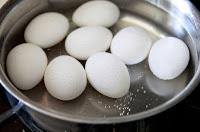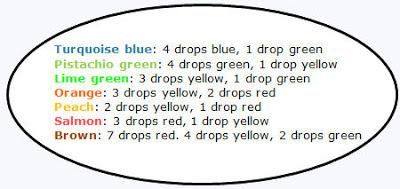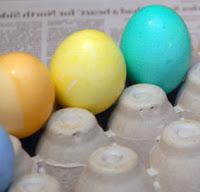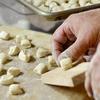 6 eggs
6 eggsWater for boiling
Egg Dye:
1 cup boiling water (you can use the water from boiling the eggs)
2 teaspoons white vinegar
food coloring
It is a good idea to test the freshness of your eggs before boiling them. The best way to test whether an egg has gone bad is to float it in water. As eggs get older, the inside portion of the egg starts to decompose and gases build. Hence it floats. A fresh egg will not float, but lie at the bottom of the glass of water.
 Place eggs into a pot of cold water, and then cover it and bring it to a boil. Once the water is boiling remove the pan from the heat, and let stand for 12 minutes. Then place the eggs in a bowl of cold water to cool as you begin peeling them under cold water.
Place eggs into a pot of cold water, and then cover it and bring it to a boil. Once the water is boiling remove the pan from the heat, and let stand for 12 minutes. Then place the eggs in a bowl of cold water to cool as you begin peeling them under cold water.Before preparing egg dyes, cover your work surface with newspaper to soak up spills. Then, mix boiling water and vinegar and divide into small containers large enough to place one egg covered with liquid. Add food coloring for colors desired using the color chart (or experiment with your own!) Many companies now makes neon food colorings too.
 When dyes are ready, place boiled eggs in the containers one at a time. Metal spoons acan leave unwanted marks on the eggs, so use a plastic spoon “baste” the egg with the egg dye until the color is as dark as you like.
When dyes are ready, place boiled eggs in the containers one at a time. Metal spoons acan leave unwanted marks on the eggs, so use a plastic spoon “baste” the egg with the egg dye until the color is as dark as you like.Eggs can be “batiked” by placing stickers or decals on the eggs and then removing them once the dye has dried. Stars, dots, and even hole-reinforcing loops make great designs. Wrapping the eggs with rubber bands creates stripes. Another idea is to use a white crayon to write mystery messages or designs which “appear” when the eggs are dyed.
Allow the eggs to dry on an egg carton (cardboard works better than styrofoam) that has been turned upside down.Paper towels work well but eggs can roll off.
April 22, 2011

